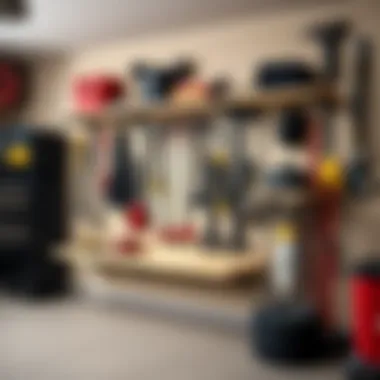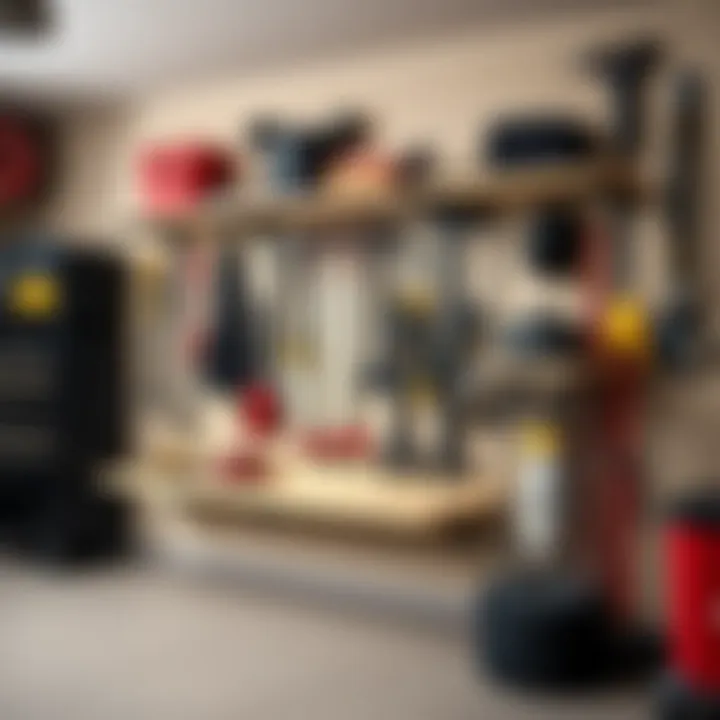Maximizing Garage Space with Smart Racking Solutions


Intro
Garage spaces often become a catch-all for items that spill over from the house—old furniture, seasonal decorations, and gardening tools, to name a few. This uninviting clutter can make that area both dysfunctional and challenging to navigate. However, with thoughtful racking solutions, transforming a chaotic garage into a neatly organized space is achievable.
This article delves into the various types of racking systems that can optimize your garage space while considering aspects like design, materials, and safety. We’ll discuss practical insights that resonate with homeowners and designers alike, arming you with the necessary tools to enhance your storage capacity effectively.
Whether your goal is to create a workshop, an efficient storage area for sports equipment, or a tidy place for gardening supplies, selecting the right racking system is crucial. Let’s unravel the nuances of various racking solutions to streamline your garage organization and improve accessibility and usability.
Understanding the Need for Garage Racking
Garages often serve as dumping grounds for various items, from holiday decorations to tools and bicycles. The clutter can become overwhelming, leading to the feeling of being lost in a sea of chaos rather than a functional space. This is why understanding the need for effective garage racking is essential. Proper racking not only organizes space but also enhances its usability.
Common Challenges in Garage Storage
Many homeowners face recurring issues when it comes to garage storage. Often, it's the sheer amount of stuff that can lead to a cluttered and unusable space. Finding a place for seasonal items, equipment, and tools becomes a daunting task. Moreover, the standard shelving often lacks flexibility. Items can quickly become disorganized, causing stress when looking for something specific. Also, some people may underestimate the space they require or overestimate the capacity of their current storage solutions.
A few common challenges include:
- Limited vertical space: Many garages have high ceilings, yet homeowners often underutilize this potential.
- Difficult access: Items stored at the back of poorly designed shelves can seem almost unreachable.
- Safety hazards: Clutter can present safety risks, making it hard to navigate the space.
- Unclear categorization: Different types of tools and supplies often get mixed together, creating a situation where nothing can be found quickly.
In short, the combination of congestion and a lack of proper planning contributes significantly to frustration in the garage.
How Racks Improve Space Utility
Racks play a pivotal role in transforming a disorganized garage into a practical and efficient storage area. They elevate items off the floor and make full use of vertical space. This can be especially beneficial for individuals who struggle with limited square footage. By implementing well-thought-out racking solutions, one can reimagine how space is utilized.
Benefits of using racks include:
- Increased Storage Capacity: Racking maximizes your available space by utilizing vertical height effectively.
- Easy Visibility: Organized racks allow you to see what you have at a glance, reducing the time spent searching for items.
- Enhanced Safety: Elevated storage minimizes tripping hazards and helps keep heavier items off the floor.
- Customizability: Many racking systems offer adjustable shelves that cater to various sizes and types of items, making it easy to adapt to personal needs.
- Organizational Structure: Racks support a more systematic approach to storage, often filtered through categories or usage frequency, thereby promoting a more efficient workspace.
"Effective garage racking can turn a chaotic storage area into a streamlined space where everything has its place."
Types of Garage Racking Systems
Understanding the various types of garage racking systems is paramount for homeowners aiming to harness the full potential of their garage space. Different racks serve distinct purposes, making it crucial to choose the right style based on your specific storage needs, available space, and personal preferences. With the right racking solution, you can declutter, organize efficiently, and make the most of every square inch.
Shelf Racks
Shelf racks are perhaps the most straightforward yet versatile option available for garage storage. They typically come in multiple tiers, allowing users to stack bins or boxes neatly while keeping everything visible and accessible.
These racks are perfect for storing items like tools, paints, and gardening supplies, which homeowners often need but want to keep off the garage floor. By implementing shelf racks, one can turn a chaotic space into an organized haven, ensuring that every item has its place.
Benefits of Shelf Racks:
- Maximized Vertical Space: Shelf racks take advantage of vertical height, freeing up valuable floor space for larger items like vehicles or bicycles.
- Customizable Options: Many shelf racks can be adjusted in height to accommodate items of differing sizes, making them incredibly adaptable.
- Cost-Effective Solutions: Generally, shelf racks can be purchased or constructed at relatively low costs, providing excellent value for budget-conscious homeowners.
Wall-Mounted Racks
Wall-mounted racks offer a sleek and efficient way to store items without sacrificing floor space. They attach directly to the garage wall, creating a functional display for tools, bikes, or other outdoor gear. This type of rack minimizes clutter and allows for easy access.
Considerations When Choosing Wall-Mounted Racks:
- Weight Limits: Always check the weight limits to ensure safety; they can vary significantly between models.
- Installation Requirements: Proper installation is paramount; if not done correctly, you risks damaging both the rack and the wall.
- Arrangement Flexibility: Users can design their own layout, creating intentional organization that suits their workflow and lifestyle.
Freestanding Racks
Freestanding racks are versatile and can be positioned anywhere in the garage. Unlike wall-mounted options, they don’t require installation, making them an appealing choice for renters or those hesitant to modify their walls.
These racks typically come in various sizes and materials, offering solutions for multiple storage issues. They're great for bulky or odd-sized items that don't fit neatly on shelves.
Key Benefits of Freestanding Racks:
- Portability: Easily move them around as needed, which is particularly handy during garage reorganizations or cleanouts.
- Wide Variety: Available in numerous designs, from heavy-duty metal for holding large items to simpler wood designs for lighter loads.
- Expandable Solutions: As storage needs change, it's easy to add or replace freestanding racks without major overhauls.
Overhead Racks
Overhead racks are designed for optimal space efficiency, utilizing ceiling space that often goes ignored. These racks are excellent for storing seasonal items or less frequently used equipment, effectively keeping valuable floor space free.
However, they require careful consideration of your garage height, ensuring that access to stored items is feasible.
Advantages of Overhead Racks:
- Space Liberation: Greatly reduces clutter by utilizing otherwise wasted ceiling space.
- Easy Access: Ideal for items like holiday decorations or camping gear that you might not need daily.
- Sturdy Designs: Many are made from robust materials, ensuring they can support heavier loads.
In summary, selecting the right type of racking system is crucial in optimizing your garage storage. Consider all aspects from space availability, weight capacity, and accessibility when choosing the right option for your needs. Each type has unique benefits and can significantly impact the functionality of your garage.
Materials for Racking Solutions
When it comes to optimizing garage space, selecting the right materials for racking solutions is not just about aesthetics or preference. Each material brings distinctive traits to the table—strength, durability, cost-effectiveness, and maintenance considerations—all playing significant roles in how well your garage systems function.


Durability and Longevity
The materials used in racking systems determine how long they will last under various conditions. For instance, garages often experience temperature fluctuations and humidity changes, which can affect certain materials more than others. Choosing a material that can withstand the conditions of your specific environment will save you the hassle of frequent replacements.
Load Capacity
Understanding the weight limits of racking materials is crucial. Some materials can handle heavy loads while others can't. This is essential when you’re dealing with tools, equipment, or seasonal items that could be relatively heavy. Knowing the limitations of your chosen racking material allows for safer storage and better use of space.
Aesthetic and Practical Considerations
While function is king, the visual appeal of your racking system shouldn't be entirely overlooked. The look of your garage can greatly affect how much you enjoy using that space. Consider materials that not only perform well but also offer a clean, organized appearance to complement your garage's design.
Cost Implications
Price is always a factor. Different materials come with varying price points, so understanding your budget will guide your decisions. Compare the initial setup costs with long-term durability and maintenance expenses to find a balance that fits your financial situation.
In summary, the choice of materials is interconnected with functionality, safety, and personal preference. Now, let's break down the various types of materials commonly used in garage racking systems.
Metal Racks
Metal racks are typically the juggernauts of the garage racking world. They are known for their strength and load-bearing capacity, making them ideal for holding heavy tools, equipment, and supplies.
Metal racks commonly use steel or aluminum, which ensures they resist wear and tear in the long run. They often come with a powder-coated finish, which protects against rust and corrosion, contributing to their overall durability. Their rigid structure provides a stable storage solution that doesn’t easily sag or warp.
Moreover, metal racks are often customizable in terms of size and shelving configurations. Homeowners can fit them into various spaces, accommodating everything from small tools to larger equipment. Their open design also allows for ventilation, which can be particularly beneficial in avoiding moisture buildup. However, one aspect to keep in mind is that they can be heavier and potentially require more effort for installation.
Wooden Racks
Wooden racks are often associated with a rustic, classic charm, appealing to homeowners wanting a warmer, more inviting aesthetic in their garages. They can be crafted from a variety of woods, including treated pine and plywood, which can provide a robust level of strength suitable for lighter items.
With wooden racks, versatility shines through as they can be designed to accommodate different shapes and sizes. You can easily paint or stain them to match your garage decor, creating a cohesive look. Wooden racks can also be a fun DIY project, allowing for personalization that perfectly fits your space.
On the flip side, wood is sensitive to environmental factors like moisture and temperature. Without proper treatment, there’s a risk of warping or rot over time. It’s essential to keep this in mind if your garage tends to be more humid or fluctuates in temperature.
Plastic Racks
Plastic racks are gaining popularity for their lightweight nature and resistance to corrosion, making them another reliable option for garage storage. Often constructed from high-density polyethylene or polypropylene, they are both economical and versatile.
These racks are usually resistant to various chemicals, pending a household setting, which makes them ideal for storing cleaning supplies or gardening equipment. Their lightweight design allows for easy movement and reconfiguration, so you can adapt your layout easily without heavy lifting.
However, while they might be visibly pleasing, sometimes they don’t hold up quite as well under heavy loads compared to metal options. Assessing what the racks will store is crucial.
Innovative Hybrid Options
As advancements continue in storage design, hybrid options have emerged that blend elements from different materials to create versatile racking systems. These might combine the stability of metals with the visual appeal of wood, or integrate plastic pieces for affordability and weight considerations.
For example, a racking system might feature wooden shelves supported by a metal framework. This combination takes advantage of weight distribution while providing a stylish look. Additionally, hybrid racks often offer improved features such as adjustable shelf heights and modular designs, allowing for easy modification as needs change.
These innovative designs can often suit a variety of user preferences and storage needs, making them an attractive choice for homeowners looking for customization.
To summarize, selecting the right materials for your garage racking systems is pivotal in achieving optimal storage solutions. With options ranging from sturdy metal to rustic wood, to practical plastic and even modern hybrid designs, there's a material out there that will meet both your functional and aesthetic needs. Considering durability, load capacity, and overall cost will help you make the best choice for your garage organization plan.
Assessing Your Garage Space
Assessing the layout and utility of your garage is akin to drawing a blueprint before constructing a house. It's about seeing beyond the clutter and envisioning how every inch can work to your advantage. The importance of this assessment can't be overstated—it sets the groundwork for choosing the right racking solutions tailored to your individual needs. A thorough evaluation allows homeowners not only to maximize the available space but also to optimize for ease of access and organization.
When you take a step back and start to measure elements in your garage, you’re engaging in a critical practice that impacts functionality. This process involves considering height, width, and depth—dimensions that will dictate what types of racking systems fit best. In addition, assessing your garage helps in identifying areas of inefficiency, such as those corner spots that tend to be a dumping ground for miscellaneous items.
Benefits of Assessing Your Garage Space
- Space Optimization: Understanding dimensions ensures you utilize areas that are often overlooked.
- Tailored Solutions: Knowing your storage requirements helps in selecting appropriate racking types.
- Enhanced Safety: Identifying hazards or obstructions leads to a safer environment.
Having a good handle on these considerations before you make a move on purchasing solutions gives you an edge. You'll have a solid sense of what fits and what doesn’t, preventing unwanted surprises during installation.
Measuring Your Garage
Measuring your garage isn’t just about taking a tape measure to the walls. It involves a careful and intentional process that captures all the important dimensions and features—like windows, doors, and ceiling height. By doing so, homeowners can calculate the maximum available spaces for racking.
- Start with Length and Width: Measure from wall to wall; make a note of any architectural anomalies.
- Consider Ceiling Height: High ceilings can accommodate vertical racking solutions.
- Account for Fixtures: Ensure you measure around fixed structures like heaters or plumbing.
For accurate results, one handy approach is to create a scale drawing of your garage. This visual representation can really help you see how various racking systems will fit into the space.
Identifying Storage Needs
Once you've mapped out the physical dimensions of the garage, the next step is to assess what you need to store. This isn't simply identifying things—you should prioritize items based on frequency of use and size.
Take a moment to walk through your garage and make two lists: one of the things you absolutely need to keep, and another for items that you might consider getting rid of. Key questions to guide your evaluation include:
- How often do I use this item? If it hasn’t been touched in a year, perhaps it’s time to let it go.
- What’s the size of each item? Understanding the dimensions helps determine the size of the racks you’ll need.
- Are there seasonal items? Such as gardening tools or winter gear—these often require specially designated space.
With a clear understanding of your storage needs, you can now make informed decisions on what type of racking solutions to implement, ensuring every square foot in your garage is employed effectively.
"Measuring and assessing your garage isn't just a step; it's the foundation on which your storage solution is built."
By focusing on these specific elements, you will be well on your way to transforming your garage into an organized and functional space.
Installation Considerations
When it comes to optimizing garage space through racking systems, understanding installation considerations is paramount. The manner in which racks are installed can significantly dictate their effectiveness in maximizing storage and ensuring safety. Whether you choose to tackle the installation yourself or hire someone to do it for you, knowing the ins and outs of the process can save you a heap of trouble down the line. A well-installed racking system should not only accommodate your existing items but also adapt to future needs.
DIY vs. Professional Installation


Choosing between DIY installation and professional help really boils down to your confidence and skill level. A lot of homeowners take the plunge into DIY, valuing the cost savings and the satisfaction that comes with self-installation. If you're of the mindset that you can measure twice and cut once, this approach has its perks. You get the chance to customize your racking system to your specific needs.
However, it’s worth being honest here: some racking systems are more complex than others. For instance, wall-mounted racks require precise drilling and anchors, while free-standing units might need leveling. If the thought of dealing with measurements and tools makes your palms sweat, enlisting professionals could be the wisest choice. They not only know the ropes, but they also bring experience that can translate to quicker installations and fewer errors.
Tools Required for Installation
If you go the DIY route, gathering the right tools is essential to avoid any hiccups. Here’s a list of common tools you might need:
- Drill: For creating holes in the wall and securing anchors.
- Level: Ensures that everything is straight as an arrow.
- Stud Finder: Helps identify where to drill into the studs for maximum support.
- Screwdriver: A good addition for securing bolts and screws tightly.
- Measuring Tape: Accurate measurements are the foundation of a well-installed racking system.
- Wrench: Useful for tightening bolts, especially in heavy-duty systems.
These tools aren’t just handy; they are crucial for ensuring the stability and longevity of the racks. Without the right equipment, you could find yourself in a precarious situation, with racks that wobble or worse, collapse.
Safety Precautions
No matter how you choose to approach your rack installation, safety should be at the forefront of your mind.
"A falling rack can be more than just messy; it could cause injuries or damage items that have sentimental value."
Here are some key safety precautions to keep in mind during installation:
- Wear Safety Gear: A hard hat, goggles, and gloves can protect you from any unintended accidents.
- Check Weight Limits: Each racking system has a specified weight capacity. Overloading can create hazardous conditions.
- Avoid Overreaching: When installing racks, make sure to use a sturdy ladder or step stool to reach high areas safely.
- Secure Items Properly: Once installed, ensure items are stowed properly to prevent them from tipping or falling.
- Periodic Checks: After installation, regularly check the integrity of the racks and ensure all screws are tight and no parts are deteriorating.
By considering these factors, you’ll enhance your garage's functionality while keeping yourself and your belongings secure.
Maximizing Racking Efficiency
Maximizing racking efficiency is more than just a catchy phrase; it's a crucial approach that can transform your garage from a chaotic storage zone into a well-organized haven. Think about the clutter you often face. Tools misplaced here, holiday decorations crammed there—this inefficient use of space not only leads to frustration but can also be a safety hazard. Properly designed racking systems streamline your storage solutions, making your life easier and your garage more functional.
Hierarchical Storage Methods
Implementing hierarchical storage methods in your garage optimization strategy boils down to understanding what you need to access most frequently. Imagine your garage is a library of sorts. If you place the books (or items in this case) you reach for often, at eye level, everything becomes easier.
- Everyday Use Items: Store items that you use regularly on lower shelves that are easily accessible. This could include tools, gardening supplies, or frequently used sports equipment.
- Moderate Access Items: These are things you don’t use every day, but still need access to occasionally, like seasonal decorations or spare bathroom supplies. Place these items on middle shelves.
- Rarely Used Items: Store seasonal items or things that you might not touch for months or even years on the highest shelves or in less accessible spaces. These could be camping gear or that air mattress you only inflate during family gatherings.
This method can save you valuable time and energy, ensuring that you can quickly locate what you need without rummaging through piles.
Rotational Organization
Rotational organization is about making sure that you use what you have before it’s out of date or out of mind. It’s like the age-old adage: "out with the old, in with the new." Having a designated system for rotation can be particularly useful for items like chemicals, cleaning supplies, and even food storage.
- First In, First Out (FIFO): This principle is essential for items with expiration dates. Organize new items behind older ones so that you reach for the older products first.
- Monthly Review: Set a reminder to check your stock monthly—think of it as a mini-inventory check. Are there items that need to be disposed of because they’re reaching their end? Waste not, want not!
- Clear Containers: Using clear totes allows you to easily see what you have on hand, reducing the chances of duplicate purchases or unused items taking up precious space.
Overall, rotational organization maximizes your racking efficiency by ensuring that you are actively using your space, thus preventing waste.
Seasonal Adjustments
Let’s face it; our needs change with the seasons. Having an adaptable racking system allows you to optimize your storage based on what items are needed at different times of the year. No one wants last summer’s beach chairs to take up space when winter sports are around the corner.
- Seasonal Inventory Check: Seasonally assess what you need available in the garage. For spring and summer, you might prioritize gardening tools and outdoor furniture over winter supplies.
- Storage Bins: Utilize labeled bins that can be easily exchanged depending on the season, storing off-season gear comfortably away. A trip to the garage shouldn’t feel like a scavenger hunt each time you need winter boots!
- Height Adjustments: If your racking system allows, modify the height of shelves depending on seasonal needs. Tall items like sleds can be lowered when it's wintertime, while the same area can be adjusted for more accessible summer gear.
In summary, focusing on maximizing racking efficiency involves a blend of smart planning, adaptable organization strategies, and an awareness of your own needs. Getting your garage in order allows for more than just neatness; it presents a clear path to making the most of the space and ultimately streamlining your daily life.
"An organized garage is not just about having a place for everything; it's about creating space for what truly matters."
For more information on efficient garage organization solutions, you can explore resources like Wikipedia.
Optimizing your garage space is an ongoing process that pays dividends in convenience and peace of mind.
Comparing Cost Efficiency
When it comes to upgrading your garage with racking solutions, assessing cost efficiency is a crucial step. You can find a wealth of options on the market, from budget-friendly to high-end systems. However, it's not only about finding the cheapest option; it's about what makes sense for your space and your needs. Knowing how to compare costs against functionality can help you make an informed decision that balances your wallet and storage requirements.
Cost efficiency offers several benefits:
- Long-Term Savings: Investing in well-made racks can save you money down the road. Cheaper units may need replacing sooner than later, leading to more spending.
- Function over Price: A well-selected racking system directly correlates with storage success. Understanding the utility you get for the price is key.
- Budget Management: You’ll want to allocate funds wisely across various areas of improvement in your garage, whether it's racks, tools, or renovation.
Budgeting for Racking Solutions
Creating a budget for garage racking solutions can seem daunting, but breaking it down can ease the pressure. First, assess what you need. Start with measuring your space accurately. Identify specific items that require storage and any unique needs like seasonal items or frequently used tools.
- List out Items: Make a comprehensive inventory of what will live in your garage. This can help pinpoint the type and amount of storage that will be required.
- Research Options: Once you have a solid understanding of your needs, do some homework on available racks. Many retailers provide cost ranges, and a quick comparison will land you on the right track.
- Emerging Trends: Consider not just current prices but upcoming trends that might affect costs. For example, substantive shifts toward sustainable materials might create options that are pricier now but become standard over time.
Making a budget allows you to prioritize not only what you can afford but what brings the best value.
Cost vs. Functionality Analysis


Evaluating cost against functionality is where true discernment shines through. Some may think that spending less is invariably saving more. However, it’s essential to tease apart the initial price from the longevity and usability it buys you.
- Quality Materials: Metal racks may cost more upfront but are generally sturdier and longer-lasting compared to lower-cost plastic options. A deeper pocket now might save you lots later,
- Design Versatility: Some racks offer adjustable shelving, making it easier to adapt storage spaces to changing needs. A little more investment here is often worth it for the flexibility down the line.
- Space-Saving Features: Evaluate the footprint. Racks that utilize vertical space tend to offer better storage solutions than those that stretch flat and take more floor real estate.
In the long run, it's about understanding what you get and if it meets your needs more effectively than other options.
"Sometimes spending a little more upfront can lead to less hassle and expense over time."
Ending
In summary, a thorough examination of cost efficiency when planning your garage racking is invaluable. By budgeting wisely and analyzing cost versus functionality, you set the stage for a workspace that not only meets your ever-evolving needs but stands the test of time.
Common Mistakes to Avoid
When setting up garage racking solutions, the path is often strewn with pitfalls. It’s easy to get carried away with the excitement of wanting to maximize every nook and cranny, but overlooking some critical aspects can lead to mistakes that cost both time and money. Understanding these common missteps not only enhances your racking setup but also protects your investment in terms of both functionality and safety. After all, the goal is to create a space that's organization-friendly, and each error can tarnish that vision.
Underestimating Load Capacities
One of the more troublesome oversights is underestimating load capacities. Imagine a scenario: you install a sleek new set of shelves, fill them with boxes and tools, only to find them buckling under the weight. This situation is more common than you'd think. Each racking system comes with specific load limits dictated by its design and materials. Ignoring these can lead to catastrophic failures, not just in terms of lost items but also potential injuries.
It is crucial to carefully read the manufacturer's specifications regarding weight allocation. Don’t just assume that a shelf can handle more than it comfortably can. For instance, a metal rack may appear robust, but if it’s rated for 200 pounds and you pile on 300, you’re asking for trouble. Follow these guidelines to avoid miscalculating:
- Know the Load Limits: Familiarize yourself with the weight capacities specified by brands such as Gladiator or Fleximounts, to name a couple.
- Distribute Weight Evenly: Instead of shoving all heavy items on one side, practice even distribution.
- Use Additional Supports When Needed: If a load seems borderline high, consider adding extra supports or opting for a more heavy-duty option.
"Measuring twice is always better than repairing once."
Ignoring Safety Standards
Next on the list is the tendency to ignore safety standards and guidelines. When adding racking systems, complying with safety measures is not just a recommendation; it’s a requirement. Neglecting proper installation procedures can lead to accidents. For example, failing to secure wall-mounted racks can result in a shelf falling, potentially harming anyone nearby.
To keep your garage both organized and safe, consider these points:
- Follow Local Regulations: Look into local safety codes, which may dictate how storage systems need to be installed. Websites like may have relevant local guidelines.
- Use the Right Fasteners: Always use the recommended fasteners that are suitable for the type of wall and the racking system you’ve chosen. Different materials require different fasteners.
- Perform Regular Inspections: After installation, check your racks regularly. Look for signs of wear and tear or any items that may have shifted positions.
Ultimately, by avoiding these common mistakes, you can create a garage space that isn't just maximally efficient, but also safe for everyone who uses it. After all, adding to the functionality of your space shouldn’t compromise its safety.
Future Trends in Garage Racking
As we navigate through an era of constant innovation, it's crucial to stay informed about the future trends in garage racking systems. These trends not only shape the way we organize spaces but also enhance functionalities that can optimize our usage of garage areas. Therefore, understanding these trends is beneficial for homeowners, designers, and decorators alike, who want to maximize their garage's potential while keeping aesthetics and practicality in mind.
Technological Innovations
In the realm of garage racking, technology is leading the charge in optimizing how we store our belongings. Advanced solutions like smart shelving systems are gradually becoming popular. These systems can connect to home networks, providing users with data regarding what items are being stored and even track usage over time. Imagine a scenario where a homeowner receives a notification if a particular item hasn't been used in months. Not only does this help in decluttering, but it also gives insights into what needs to be easily accessed.
Furthermore, automated racking systems are making waves. These systems allow items to be retrieved with the mere press of a button. While these automated systems often come with a higher price tag, the time-saving benefits can be immense. For instance, a mechanic who needs quick access to tools can save precious time by having important items at the tip of their fingers rather than combing through shelves.
Another technological advancement is the integration of augmented reality (AR) applications for planning racking installations. Users can visualize how different racking configurations look in their own garages before making a physical change. This feature offers a personalized touch, enabling homeowners to make more informed decisions about their space.
Sustainable Material Usage
The push towards sustainability is not just a trend but a necessity in today’s world, influencing everything from home construction to the materials used in garage racking. More consumers are seeking options made from recycled or sustainably sourced materials. Racks made from bamboo, for example, are gaining traction due to their rapid growth cycle and durability.
This emphasis on sustainability extends to modular systems that allow for easy customization. Systems that enable homeowners to add or remove parts as their needs change represent a more sustainable choice compared to traditional static installations. It minimizes waste, as only what is necessary is built and future adjustments don't require complete overhauls.
Highlighting eco-friendliness in product descriptions is becoming essential for brands seeking to appeal to environmentally conscious consumers. By selecting racking systems crafted from sustainable materials, homeowners not only contribute to a greener environment but also showcase their commitment to responsible living.
"Choosing sustainable garage racking solutions is a step towards fostering a better planet while ensuring efficient use of space."
End
The conclusion of this guide serves as a crucial synthesis of everything covered regarding garage racking solutions. It encapsulates the importance of effective storage systems in transforming cluttered spaces into organized havens. Homeowners and designers alike can benefit immensely from understanding the core principles and practical applications of racking systems. Not only do these systems optimize garage space, but they also enhance usability and accessibility.
Right choices in racking solutions yield numerous advantages:
- Maximized Space Utilization: Proper racking transforms vertical and horizontal space, allowing for better organization of tools, equipment, and seasonal items.
- Efficiency in Access: When items are systematically arranged, locating tools and materials becomes quick and stress-free, saving time on projects.
- Safety Compliance: Awareness of load capacities and safety standards mitigates risks of accidents and injuries, promoting a secure working environment.
Additionally, as we look to the future, it's vital to stay updated on innovative approaches and eco-friendly materials that can further enhance storage solutions.
"Organizing is a process of arranging materials in a way that maximizes both function and efficiency. It simplifies life and fosters creativity in every project."
Recap of Key Points
Throughout this guide, key aspects regarding garage racking have been discussed in depth:
- Understanding Your Space: Taking accurate measurements and identifying specific storage needs is foundational to successful organization.
- Choosing the Right Systems: Various racking types - from shelf to overhead - offer tailored solutions suited to different needs and spaces.
- Material Considerations: Selecting the right material based on durability, weight capacity, and aesthetic preferences can enhance both the functionality and look of your garage.
- Installation Practices: Whether opting for DIY or professional help, following safety concerns and utilizing the proper tools is pivotal in ensuring a smoothly functioning system.
- Maximization Strategies: Hierarchical storage, seasonal adjustments, and rotational organization keep the garage dynamic and ready for any project.
Considerations for Future Storage Developments
As we look forward, several considerations shaped by emerging trends can guide future garage storage efforts:
- Smart Storage Solutions: Incorporating technology such as smart racks that can track inventory can bring a new level of efficiency to home organization.
- Sustainability Focus: Utilizing recyclable and environmentally friendly materials for racking systems provides not just functionality but aligns with growing ecological awareness.
- Customizable Designs: Future racking solutions may offer modular setups that homeowners can personalize according to their evolving needs.
- Community-Based Sharing: In the spirit of resourcefulness, promoting platforms where communities can borrow or lend tools and equipment can revolutionize the thought process around garage usage.
By keeping these considerations in mind, homeowners can not only adapt to changing needs but also maintain a garage space that is functional, efficient, and forward-thinking.



